
by Laurie Osgood | Nov 25, 2019
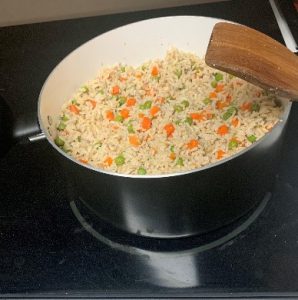
Photo credit: UF/IFAS NW District
Rice and pasta are a staple of most family meals. But did you know these simple grains can lead to a foodborne illness? Uncooked rice and pasta can contain spores of Bacillus cereus, a bacterium that can cause foodborne illness. These spores can survive even when rice or pasta is cooked. If the rice or pasta is left standing at room temperature, like in a pot on the stove, these spores can grow into bacteria. These bacteria will then multiply and produce toxins (poisons) that can cause foodborne illness. Bacillus cereus, sometimes called B. cereus, can cause nausea, vomiting, and abdominal cramps.
Preventing Contamination by B. Cereus
Because B. cereus endospores are heat resistant, they are likely to survive cooking at temperatures that would destroy other foodborne pathogens. Bacillus cereus spores can grow when exposed to heat or improper handling.
Recommendations for Proper Handling of Rice and Pasta:
- Cook rice and pasta at 135ºF or above and maintain at that temperature outside of the refrigerator.
Serve rice or pasta as soon as it is cooked.
- Cool in the refrigerator at 41ºF or below within 2 hours of cooking.
- Store rice or pasta in the fridge using a shallow container or resealable bags.
- Cooked rice or pasta can be stored in airtight containers in the fridge for 3 – 5 days.
- Do not reheat rice or pasta more than once.
During the holidays, celebrations usually center around family and good food, and, therefore, our refrigerators easily can become full. We tend to leave rice or pasta out on the stove when there isn’t any room in the fridge. This is where the problem occurs. By following proper food handling techniques, you can ensure that everyone enjoys the holidays and the fabulous foods that are part of the festivities.
To learn more about Bacillus cereus or other foodborne illnesses, contact your UF/IFAS County Extension Office.
Resources:
UF/IFAS Electronic Data Information Source (EDIS), Preventing Foodborne Illness: Bacillus cereus
The Number of Food Poisoning Cases Caused by Bacillus cereus is on the Rise. (2015, April 1). Infection Control Today. Retrieved from https://www.infectioncontroltoday.com/food-safety/number-food-poisoning-cases-caused-bacillus-cereus-rise

by Judy Corbus | Nov 23, 2019
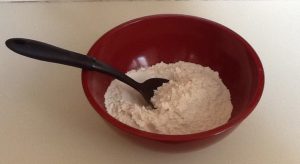
Flour is considered a raw ingredient so bake before eating. Photo credit: Judy Corbus
There is something about cooler weather that brings out the urge to bake and fill my home with delightful aromas befitting the season. Enjoying the fruits of my labor is a tasty experience but here are 8 tips I follow during prep and afterwards to keep my baked goods safe.
- Wash my hands, baking tools, appliances, and work surfaces with soap and hot water before, during, and after food prep – clean as I go!
- Break eggs in a separate bowl before adding to the batter. This keeps shell fragments out of the batter and, if the egg is spoiled, I don’t ruin the whole project.
- Never eat unbaked flour – this includes dough and batter. Flour is considered a raw ingredient, as it is minimally processed before being packaged for use. Wheat stalks in the field come in contact with birds, rodents, and other bacteria sources, which can spread E. Coli. Raw eggs can contain salmonella so bake foods to the proper internal temperature and resist the urge to lick the bowl, spoons, and beaters.
- Use a food thermometer to check internal temperatures – a brown crust does not equal doneness. Insert the probe food thermometer in the product center and wait for the temperature to maintain a level reading. This Baked Goods Internal Temperatures Chart is a handy guide for determining internal doneness. If the outside is browned but it’s not done in the middle, lay foil lightly over the crust to prevent overbrowning and continue baking until the proper internal temperature is reached.
- Always refrigerate perishable ingredients, pies, cheese-filled breads or baked goods with perishable filling ingredients (this includes eggs, custards, cheese, pizza, meats, casseroles, cream pies, puddings, and crème puffs) within 2 hours of use, preparation, or serving at room temperature. Cookie, scone, biscuit, pie, and yeasted dough may be refrigerated or frozen for later use.
- Cool baked products on clean wire cooling racks on a clean counter or table away from where raw batter or dough are prepared. Don’t cool in the baking pans or directly on counter tops.
- Wash my hands before packaging cooled products.
- Store plain yeast breads at room temperature no longer than 1 to 2 days; freeze for longer term storage. Do not refrigerate unless the bread is filled with perishable ingredients.
Enjoy your favorite baked treats safely this holiday season and beyond!
Sources: Home Baking Food Safety 101
HomeBaking.org
What’s Cooking America
North American Millers Association

by Kendra Hughson | Nov 21, 2019
You can’t tell by looking if your food is done cooking. Using a food thermometer not only ensures your food is properly cooked to reduce the risk of harmful bacteria, but it also prevents overcooking. Check out this video for more information:
Sources:
IsItDoneYet.gov
Is It Done Yet – Brochure
Proper Thermometer Placement – USDA placement
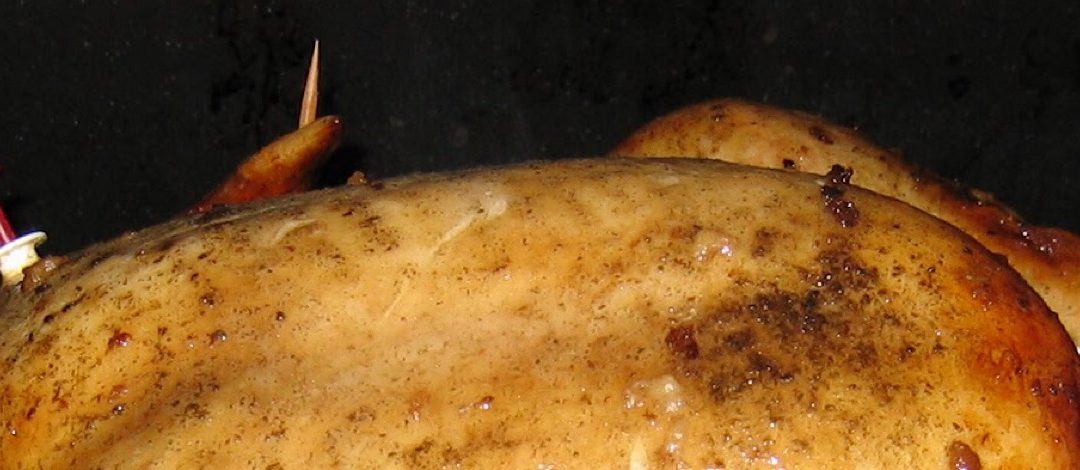
by Kendra Hughson | Nov 8, 2019
You have your frozen turkey. Now what? Plan ahead to be sure your bird is safe and ready to cook. Do not thaw your frozen turkey on the counter. All parts of the turkey must be kept at a safe temperature during the thawing process and cooked immediately after thawing. Use one or a combination of the following recommended methods:
Refrigerator Thawing
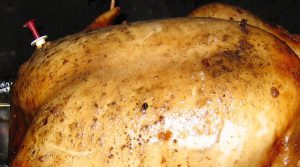
Thaw your turkey safely. Photo Credit: Kendra Zamojski
Keep the turkey in the original wrapper, placing on a tray to catch any leaking juices. Allow approximately 24 hours for every 4 to 5 pounds. For example, a 12-16-pound turkey may take 3 to 4 days to thaw. A properly thawed turkey will keep in the refrigerator for 1 to 2 days before cooking.
Thawing In Cold Water
Keep the turkey in the original wrapper and place in a larger sealed, leak-proof plastic bag. Submerge in cold water, changing the water every 30 minutes, until thawed. Allow 30 minutes per pound, so a 12- to 16-pound turkey would take 6-8 hours to thaw. A properly thawed turkey can be stored in the refrigerator.
When it’s Ready to Cook
When the turkey is ready to cook, don’t rinse it. You could splash salmonella and other bacteria around your kitchen. Cook your turkey to the proper temperature. Use a food thermometer to be sure the inner thigh, the inner wing, and the thickest part of the turkey breast are all cooked to at least 165°F.
For more information, contact your local UF/IFAS Extension office.
Sources:
UF/IFAS: Food Safety Tips for the Holiday Season
USDA: Let’s Talk Turkey
USDA: Tips and Resources for a Bacteria-Free Thanksgiving

by Samantha Kennedy | Jul 2, 2019
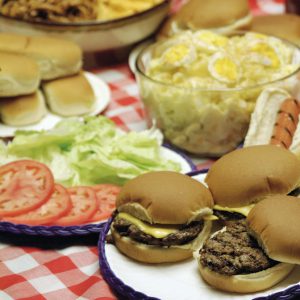
Picnics are a great way to share food and fun with friends and family. By following a few simple food safety tips, you can make sure foodborne illness doesn’t crash your party. (Photo source: UF/IFAS file photo)
There are few things more iconic during summer than a picnic. There’s just something fresh and fun about sharing a meal in the park or at the beach with family and friends. But just because you’re enjoying the warm, gentle breeze doesn’t mean you should throw caution to the wind. By following a few simple food safety tips, you can ensure that your perfectly planned picnic doesn’t make you sick.
Plan appropriately. Not all foods are picnic-appropriate. Anything that requires a lot of perishable ingredients and/or a lot of preparation should be avoided. Stick with foods that require little or no cooking and that contain just a few ingredients. Foods such as fruits and vegetables (especially whole ones), hard cheeses, peanut butter and jelly, cereal, bread, and crackers are ideal picnic items. Anything made with commercially processed custard or mayonnaise will stay safe as long as it is kept cold.
Pack it safely. Use a cooler, if possible, and store cold foods together so they can help each other stay colder longer. Use ice or frozen gel packs to help keep foods cold. Pack foods directly from the refrigerator into the cooler; don’t leave them sitting out before packing. Store ready-to-eat foods separately from raw meats. If packing up hot foods, be sure to keep them in a thermos or other insulated dish. DO NOT store them in the same container as the cold foods. Paper towels, disposable utensils, and a food thermometer are ideal picnic accessories. Remember, keep cold foods below 41 degrees F and hot foods above 135 degrees F. Do your best to keep the cooler away from direct sunlight by storing it in the shade and be sure to replenish the ice and/or frozen gel packs when they melt. If possible, store drinks in a separate cooler so cold foods are not exposed to warm air with frequent openings of the lid to retrieve drinks. This also reduces the risk of cross-contamination, with fewer hands reaching into the food cooler.
Prepare it carefully. All food items should be kept at the proper temperature at all times. When cooking raw meats, use separate plates for the raw and cooked products and clean and sanitize utensils between uses. Cook meat to the proper recommended internal temperature to ensure doneness and safety. Click here for a list of recommended internal cooking temperatures.
Clean up quickly. Discard any perishable foods that have been left out for longer than two hours. In really hot weather (generally above 90 degrees F), foods should not be left out longer than one hour. Keep food protected in storage containers such as coolers and lidded dishes to minimize contamination from flies and other pests. Serve small portions of food at a time and keep the rest in the cooler.
Picnics are an important part of summer and with just a little bit of planning and a few useful tips and tools, they can be safe and delicious for everyone!
Related links:
Food Safety at Tailgating (University of Florida/IFAS)
Picnic Safety (Iowa State University)
Checklist for the Perfect Summer Picnic (foodsafety.gov)
Extension classes are open to everyone regardless of race, creed, color, religion, age, disability, sex, sexual orientation, marital status, national origin, political opinions or affiliations.









